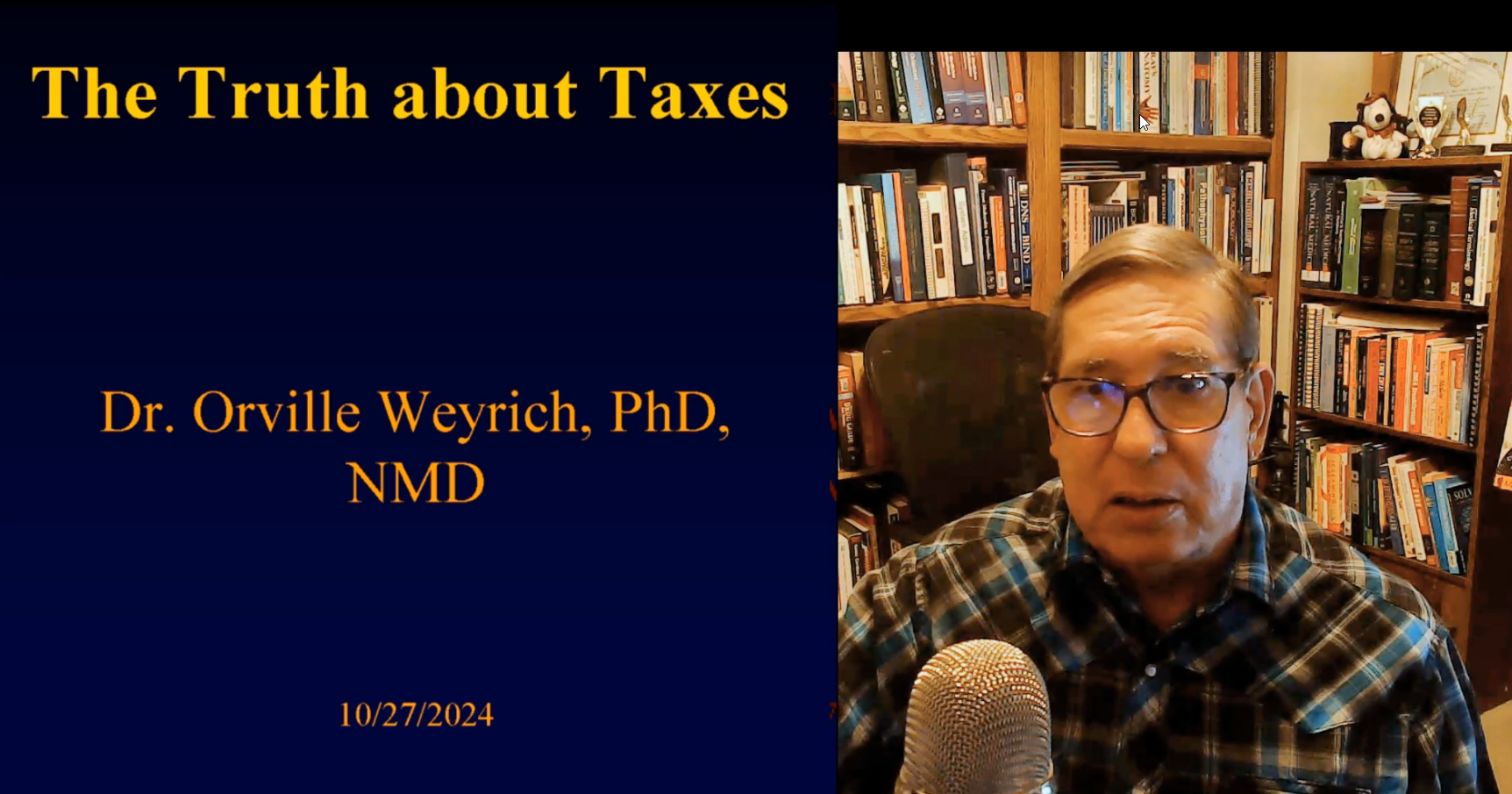Today's Topic
In this YouTube podcast edition, Dr. Weyrich discusses the economics behind current controversies regarding taxes - especially Tariffs Income Tax, and Inflation. The economic multiplier theory is used to discuss the pros and cons of different kinds of taxation, and both supply and demand approaches to reducing inflation are discussed.
Annotated Outline
The Truth about Taxes
Dr. Orville Weyrich, PhD, NMD
10/27/2024
Annotations are shown in this font.
Basic Truths about Taxes
- Nobody likes being taxed.
- Some level of taxation is necessary:
- E.g. Articles of Confederation
 Cite accessed 10/31/2024
Cite accessed 10/31/2024
- E.g. Articles of Confederation
- Any activity that is taxed will be suppressed:
- E.g. Tobacco.
- This effect is most profound for nice-to-have but not essential products
(that have an "elastic demand curve"),
but relatively small for essential products (that have an "inelastic demand curve").
 Cite accessed 10/31/2024
Cite accessed 10/31/2024
- Any activity that is not taxed given a tax credit will be enhanced.
- Public policy (i.e. Congress) dictates which activities will be taxed or untaxed given a tax credit.
- Tax policy determines the prosperity of a nation.
- Who you vote for matters!
Examples of Taxes
- Sales tax - impacts low income people more (is "regressive").
- Use taxes (gas, toll-roads, etc.)
 Cite accessed 11/01/2024
Cite accessed 11/01/2024
- Value-added tax
 Cite accessed 11/01/2024
Cite accessed 11/01/2024
- Tariffs
- Income tax - impacts high income people more (is "progressive"). In the United States for 2025,
the marginal tax rate (after deductions, credits, and adjustments are made) ranges from
10% for incomes of $11,925 or less up to 37% for incomes greater than $626,350.
 Cite accessed 10/31/2024
In 2021, individual taxpayers with more than the median income (upper middle class and above)
paid 97.7% of all federal individual income taxes, while those below the median income
(lower middle class and below) only paid 2.3%.
Cite accessed 10/31/2024
In 2021, individual taxpayers with more than the median income (upper middle class and above)
paid 97.7% of all federal individual income taxes, while those below the median income
(lower middle class and below) only paid 2.3%.
 Cite accessed 10/31/2024
Cite accessed 10/31/2024
- Property tax
- Inflation - A hidden tax; see below).
- Capital gains - A tax applied to the "profit" from selling an asset held 1 year or more
(e.g. a home, stocks, gold, a factory, etc.) for more than the original purchase price of that asset.
Unfortunately, this "profit" is NOT adjusted for inflation; see below.
 Cite accessed 10/31/2024
Cite accessed 10/31/2024
- Unrealized capital gains tax - Proposed by Vice President Harris; see below).
This tax suffers from all of the same issues as regular capital gains tax, plus it reduces investment capital
to expand an enterprise (reducing potential growth economicactivity, jobs, and the Gross Domestic Product
(GDP). In addition it's rules are complex and introduce significant new accounting and enforcement costs.
 Cite accessed 10/31/2024
Cite accessed 10/31/2024
- Inheritance tax
- Regulations (a form of fascism) - According to Wikipedia [trust but verify],
"In general, fascist governments exercised control over private property but they did not nationalize it ...
big business developed an increasingly close partnership with the Italian Fascist and German
Nazi governments after they took power.
Business leaders supported the government's political and military goals.
In exchange, the government pursued economic policies that maximized the profits of its business allies."
 Cite accessed 11/01/2024
Cite accessed 11/01/2024
Economic Multiplier Effect on the US Economy
- Based on economic theories of John Maynard Keynes (1883-1946).
- American workers are paid for producing goods and services to be sold (they also pay income tax).
- These workers spend their money in their community, thus providing jobs for additional American workers, who also spend their money in their community (and also pay income tax).
- The cycle is broken when foreign goods are purchased, taxes siphon off the money, the money is used to repay debts, or is put into savings.
-
 Cite accessed 11/01/2024
Cite accessed 11/01/2024
 Cite accessed 11/01/2024
Cite accessed 11/01/2024
Law of Supply and Demand
- It is generally observed that the market price of a product (goods or services) depends both on the available supply of the product and the consumer demand to buy that product.
- Supply generally increases when the market price increases, because producers are incentivised to produce more.
- Demand generally decreases when the market price increases, because consumers are less willing or able to buy.
- Economic models of supply and demand must take into account factors that are different for different
products and services, such as market elasticity and the availability of competing
products and services.
 Cite accessed 11/01/2024
Cite accessed 11/01/2024
Compare
Tariffs
- Discourages purchase of foreign-made goods (import tax raises cost and reduces demand) that promote economic activity in foreign countries (instead of our own).
- Promotes purchase of domestic goods and promotes domestic economic activity
(and grows jobs in the USA).
- Positively affects the domestic economic multiplier effect (and grows jobs in the USA).
- Allows income tax to be reduced without reduced tax revenue,
- Promotes balanced trade.
 Cite accessed 11/01/2024
Just as a balanced household budget is essential for economic security,
so is balanced international trade. In 2023 the USA suffered a $386 Billion trade deficit
with China, a geopolitical opponent that is using this money to build their military
against the USA and our allies (Australia, Taiwan, Japan, South Korea, Philippines, etc.) and also
to buy farmland in the USA.
Cite accessed 11/01/2024
Just as a balanced household budget is essential for economic security,
so is balanced international trade. In 2023 the USA suffered a $386 Billion trade deficit
with China, a geopolitical opponent that is using this money to build their military
against the USA and our allies (Australia, Taiwan, Japan, South Korea, Philippines, etc.) and also
to buy farmland in the USA.
 Cite accessed 11/01/2024
In effect, the USA is losing a trade war with China.
Cite accessed 11/01/2024
In effect, the USA is losing a trade war with China.
Income Tax
- Discourages the domestic economic activity of both workers and the corporations who employ them.
- Negatively affects the domestic economic multiplier effect.
- Extreme example: The Plymouth (Mayflower) Colony (Gov. William Bradford). See in particular pages [162] to
[164]
 Cite accessed 10/31/2024
Cite accessed 10/31/2024
Excerpt from the History of Plymouth Colony by Gov. William Bradford
Anno Dom: 1623.
So they begane to thinke how they might raise as much corne as they could, and obtaine a beter crope then they had done, that they might not still thus languish in miserie. At length, after much debate of things, the Govr (with ye advise of ye cheefest amongest them) gave way that they should set corne every man for his owne perticuler, and in that regard trust to them selves; in all other things to goe on in ye generall way as before. And so assigned to every family a parcell of land, according to the proportion of their number for that end, only for present use (but made no devission for inheritance), and ranged all boys & youth under some familie. This had very good success; for it made all hands very industrious, so as much more corne was planted then other waise would have bene by any means ye Govr or any other could use, and saved him a great deall of trouble, and gave farr better contente. The women now wente willingly into ye feild, and tooke their litle-ons with them to set corne, which before would aledg weaknes, and inabilitie; whom to have compelled would have bene thought great tiranie and oppression.
The experience that was had in this commone course and condition, tried sundrie years, and that amongst godly and sober men, may well evince the vanitie of that conceite of Platos & other ancients, applauded by some of later times; - that ye taking away of propertie, and bringing in communitie into a comone wealth, would make them happy and florishing; as if they were wiser then God. For this comunitie (so farr as it was) was found to breed much confusion & discontent, and retard much imployment that would have been to their benefite and comforte. For ye yong-men that were most able and fitte for labour & service did repine that they should spend their time & streingth to worke for other mens wives and children, with out any recompence. The strong, or man of parts, had no more in devission of victails & cloaths, then he that was weake and not able to doe a quarter ye other could; this was thought injuestice. The aged and graver men to be ranked and equalised in labours, and victails, cloaths, &c., with ye meaner & yonger sorte, thought it some indignite & disrespect unto them. And for mens wives to be commanded to doe servise for other men, as dresing their meate, washing their cloaths, &c., they deemd it a kind of slaverie, neither could many husbands well brooke it. Upon ye poynte all being to have alike, and all to doe alike, they thought them selves in ye like condition, and one as good as another; and so, if it did not cut of those relations that God hath set amongest men, yet it did at least much diminish and take of ye mutuall respects that should be preserved amongst them.
Inflation
- Increasing cost of goods and services.
- Caused by when the demand for goods and services exceeds supply.
- Drives tax increases due to:
- Capital gains
- Unrealized capital gains
- Tax bracket creep
- Sales tax
- Capital gains
Can fix by:
- Decreasing demand
- Increasing supply
Don't work:
- Price controls (decrease supply)
- Government entitlements (increases demand)
Decreasing Demand
- Demand-side Economics (Keynes, "Bidenomics", Harris)
 Cite accessed 11/02/2024
Cite accessed 11/02/2024
- Raising interest rates:
- Risks recession or depression.
- Reduces economic activity (jobs).
- Risks stagflation.
- Increasing taxes on consumers:
- Reduces economic activity (jobs).
- Repatriating uninvited immigrants:
- E.g. to reduce housing shortage.
- Reducing government spending:
- Easier said than done.
Increase Supply
- Supply-side Economics ("Reganomics", Trump).
 Cite accessed 11/02/2024
Cite accessed 11/02/2024
- Reduce regulations:
- Reduces cost of making goods and services.
- Increases domestic productivity.
- Increase supply of raw materials:
- Especially energy.
- Reduce taxes on domestic producers:
- Incentivizes domestic production.
- Critics refer to Supply-side Economics as "Trickle Down Economics" while supporters point out that
"A rising tide raises all boats."
 Cite accessed 11/02/2024
Cite accessed 11/02/2024
So, What Should We Do?
- No magic silver bullet:
- Need to balance more than approach. Most problems are multi-factorial and need a multi-factorial solution.
- Need a silver shotgun shell [Dr. Dale Bredesen].
- The 2024 election gives an opportunity to reflect on the relative merits of
Supply-side versus Demand-side economics (Trump versus Biden/Harris). One economic
indicator of the success of the two administrations is the "Misery Index", which is
calculated by adding the average unemployment rate to the average inflation rate.
Trump had a Misery Index of 6.91 while Biden/Harris has a Misery Index of 9.26.
 Cite accessed 11/02/2024
How do you feel? Were you better off under Trump or Biden/Harris?
Cite accessed 11/02/2024
How do you feel? Were you better off under Trump or Biden/Harris?
- In order to avoid trade wars, tariffs should not be applied to allies unless we have a significant trade deficit with them, and in no case more than necessary to balance trade with them.
- Tariffs are most appropriate when applied to our geopolitical adversaries and countries engaging in predatory trade practices and theft of intellectual property (e.g. China), with which we are already losing a de facto trade war.
- Winners and Losers:
- Some people benefit from current government policies and will fight change.
- We need to balance approaches to avoid unfairly burdening vulnerable populations. For example, some of the revenues generated by tariffs should be used to bolster entitlement programs that are negatively impacted by cost increases caused by the tariffs.
- Not so Fast - Do No Harm:
- Rapid changes can be disruptive.
- A sudden increase in tariffs on a product that we have no alternate supplier for can cause serious supply disruption. A slower ramp-up in tariffs gives time to develop domestic producers. The key is commitment to unwavering increases until the required domestic supply can come completely on-line. On the other hand, a rapid increase in tariffs on Chinese-made electric vehicles would not be disruptive, due to many alternative suppliers and low current market penetration in the US of Chinese EVs.
- Tax Reform Act of 1986 caused real-estate crash.
 Cite accessed 11/01/2024
Cite accessed 11/01/2024
- Another example of rapid change disrupting businesses that had long term planning and financial commitments based on the status quo.
- Address unexpected consequences.
- Don't over-correct.
- Fordney-McCumber Tariff Act (1922) has been suggested to have caused the market crash in 1929.
But note that in 1922 the US already had a positive trade balance of $997 million.
 Cite accessed 11/01/2024
Cite accessed 11/01/2024
 Cite accessed 11/01/2024
The Smoot-Hawley Tariff Act of 1930 has also been suggested to have contributed to prolonging
the Great Depression. However, some commentators suggest that these tariffs actually had minimal effect
on the US economy, because "international trade was then a relatively minor part of the US economy."
Cite accessed 11/01/2024
The Smoot-Hawley Tariff Act of 1930 has also been suggested to have contributed to prolonging
the Great Depression. However, some commentators suggest that these tariffs actually had minimal effect
on the US economy, because "international trade was then a relatively minor part of the US economy."
 Cite accessed 11/01/2024
Cite accessed 11/01/2024
- Fordney-McCumber Tariff Act (1922) has been suggested to have caused the market crash in 1929.
But note that in 1922 the US already had a positive trade balance of $997 million.
Close
Now I want to turn it over to you.
What was the most important thing you learned from this video?
What more do you want to know?
Did I say something wrong?
Let me know by leaving a comment on YouTube!
If you like this video, please share with your friends, like, subscribe to my YouTube channel, and visit the web site DrWeyrich.com (choose Multimedia Archive) where you will find additional information about this and many other topics.







